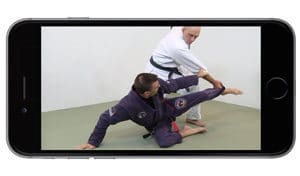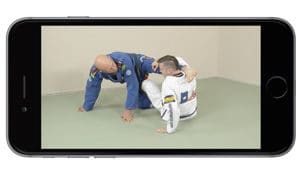Maintaining your guard and defending the guard pass are incredibly critical skills in Brazilian Jiu-Jitsu.
It is the guard that allows a smaller opponent to control and defeat a bigger attacker. And the guard allows you survive when you’re on the bottom – if you’re underneath your opponent in any other position then basically you’re losing.
Preventing the guard pass doesn’t necessarily require a huge amount of strength, speed or flexibility; there are technical, step-by-step solutions to shutting down the guard pass of a determined opponent and keeping him in your guard.
This article is all about the techniques and concepts that will allow you stop your opponent from passing your guard in BJJ. Almost all the techniques (and certainly all of the concepts) have direct application to no-gi grappling, self defense and MMA training as well.
I promise that your guard will become much harder to pass if you watch the videos on this page and train the techniques in those videos.
If you prefer you can click here to go to Youtube to check out my Guard Pass Prevention Playlist. This playlist has more than 1 hour of material on it and contains the same techniques as what you’re going to learn below.
But if you scroll down you’ll not only find those same videos but you’ll also see that I’ve added a bit of commentary for each technique that you might find helpful or interesting as well…
The Frame and Hip Escape movement taught by Rob Biernacki is maybe the most powerful guard retention concept I’ve ever come across, and that’s why I put it first.
This move doesn’t require crazy flexibility, strength or timing. If you have time to watch only one video about guard pass prevention today then start with this one. After you drill this concept and the associated techniques a few times you’ll start seeing immediate benefits to your guard game!
The Half Granby Roll looks fancy, but it’s really worth working on for almost all BJJ practitioners at every level (Rob teaches this movement on a student’s first day in class; that’s how fundamental he thinks it is). Here is why you should train the Half Granby…
First of all, it doesn’t require as much flexibility as you might initially think.
Secondly, it goes together really well with the Frame and Hip Escape movement we went through above.
Thirdly, it’s used by almost every high level guard player in the world.
And lastly, it’s cool as hell, so check it out below…
This next video is a systematic masterclass on shutting down and preventing the guard pass.
The techniques are presented in the context of defending the spider guard, but even if you don’t use the spider guard much don’t skip over this video. You can use the exact same movements to your advantage from almost every version of the open guard if your opponent is trying to blast past your legs.
There aren’t many techniques in the video below, but we really get into the weeds talking about how to train guard pass defenses. So if you’re interested in learning how to actually implement the other techniques you’ve learned on this page then make sure to give this video a quick listen.
If you’re playing butterfly guard then staying flat on your back is an open invitation for your opponent to pass your guard.
Some people’s entire guard pass strategy is to force their opponent into the reclined butterfly guard position and then pass from there. That’s how weak it is!
So if you find yourself flat on your back with the butterfly hooks in then using this one simple move to sit up will make your guard much harder to pass.
The Toreando (or the ‘bullfighter pass’) is a threat at any level of jiu-jitsu.
It’s often one of the very first guard passes that beginners learn and actually start managing to pull off in sparring.
And then there are elite world-level competitors who have made it their bread and butter guard pass and have used it to win championship after championship…
If you do BJJ then you simply have to have some reliable ways to counter the Toreando. Check out the video below for some simple and effective ways to do just that!
Bigger opponents will often take your legs, smash them to one side, and then drop their whole bodyweight onto the legs to immobilise you. Then they creep up, up, up until they get to a dominant position and make your life miserable.
In the video below BJJ black belt world champion Brandon ‘Wolverine’ Mullins shows an elegant solution to the leg fold guard pass…
My friend and training partner Ritchie Yip has a really difficult guard to pass. Fortunately for you (and unfortunately for him) he made a video showing you his patented 3 part guard pass prevention system!
This video is well worth checking out.
It sucks to be on the receiving end of a strong double underhooks guard pass.
Once your opponent has secured the double underhooks position he’s in a really good position. Your legs are effectively out of play, he has established control over your hips, and you’re about to have a TON of pressure put onto you if you don’t know what to do.
Here’s an elegant solution to that double underhooks guard pass by Rob Biernacki that doesn’t require super-strength or insane flexibility.
Learning techniques is one thing, but you also need to know how to drill them to make them instinctive! In addition to good techniques you also need a good training method!
Here’s a video I did with Ritchie Yip showing you how to drill guard pass and guard retention movements in a fast, fun and efficient manner.
The purpose of a guard pass is to pin someone. But right before you pin someone there’s usually one final opportunity to escape. Escapes that take advantage of this timing are known as ‘transitional escapes’ and they are very closely related to guard retention movements.
In the video below Emily Kwok introduces the concept of transitional escapes and demonstrates how much easier it is to escape the pin early, right after the guard pass.
If you wait for your opponent to settle down, get his grips, and ruthlessly drop all his weight onto you then you’re going to suffer. Combine guard pass prevention with transitional escapes and you’ll make life on the mats a lot more fun and pleasant!
One of the most important things to stop your opponent from passing your guard is to control the grips on your sleeves, lapels, legs or head.
In the video below I show you how this concept translates into reality, as well as some easy techniques to implement. Add this to your game and your guard will immediately become a LOT harder to pass!
Finally let’s deal with countering a low-level closed guard opening: the dreaded elbow-in-the-thigh grind.
Frankly this is a bonehead move used only by uneducated whitebelts, but if you don’t know how to counter the elbow grind then you might do some quality suffering.
Here’s exactly how to shut down the elbow grind and make your opponent suffer instead!
ADDITIONAL RESOURCES
Many of the techniques and concepts above are excerpts from Grapplearts instructional videos, apps and DVDs.
If you want more information on developing an impassable guard (and improving your bottom game in general) then I highly recommend checking out one of more of the four apps listed below…
 The Guard and Bottom Game Formula app by Rob Biernacki for Apple and Android phones and tablets has a very extensive guard retention segment, starting with, but then going way beyond, the first two featured videos in this article.
The Guard and Bottom Game Formula app by Rob Biernacki for Apple and Android phones and tablets has a very extensive guard retention segment, starting with, but then going way beyond, the first two featured videos in this article.
 The Invincible Spider Guard app by Elliott Bayev for Apple and Android Devices (also available as DVD 5 of the Spider Guard Masterclass set) is focused entirely on open guard retention. It is mostly centred on the spider guard, but the techniques in this volume really apply to any open guard situation.
The Invincible Spider Guard app by Elliott Bayev for Apple and Android Devices (also available as DVD 5 of the Spider Guard Masterclass set) is focused entirely on open guard retention. It is mostly centred on the spider guard, but the techniques in this volume really apply to any open guard situation.
 The Advanced BJJ Fundamentals app by Brandon ‘Wolverine’ Mullins (also available as DVD 1 of the Nonstop Jiu-Jitsu set). There are elements of guard retention in this instructional, but really this is a broader overview of how the fundamental movements you learn in your first few classes can be applied to advanced techniques all throughout your BJJ career.
The Advanced BJJ Fundamentals app by Brandon ‘Wolverine’ Mullins (also available as DVD 1 of the Nonstop Jiu-Jitsu set). There are elements of guard retention in this instructional, but really this is a broader overview of how the fundamental movements you learn in your first few classes can be applied to advanced techniques all throughout your BJJ career.
 The Compensating for Strength app by Emily Kwok (also available in disc form in the How to Defeat the Bigger, Stronger Opponent DVD set) covers the most essential techniques that a smaller, lighter, shorter fighter can use to defend against, and ultimately defeat, a bigger, stronger opponent.
The Compensating for Strength app by Emily Kwok (also available in disc form in the How to Defeat the Bigger, Stronger Opponent DVD set) covers the most essential techniques that a smaller, lighter, shorter fighter can use to defend against, and ultimately defeat, a bigger, stronger opponent.
All of these four apps are absolutely excellent instructionals – some of my very favourites – and I can’t recommend them highly enough!
The post Guard Pass Prevention in BJJ appeared first on Grapplearts.
